| Article ID | Journal | Published Year | Pages | File Type |
|---|---|---|---|---|
| 8910593 | Geochimica et Cosmochimica Acta | 2018 | 40 Pages |
Abstract
To fully evaluate our method, we measured lanthanide elements plus ytrrium (REY) in individual minerals, in bulk rock samples and in three separate fractions using acetate, oxalate and total digestion sequential extractions. The extraction techniques were then verified using a mass balance approach, the first time that this has been comprehensively applied to IFs. Similarities between the carbonate fraction data and modern seawater, coupled with strong measurement reproducibility and systematic stratigraphic variability suggests that carbonate most closely tracks the primary seawater composition. The Asbestos Hills IFs show distinctive REY signatures with strongly variable (Yb/Pr)SN ratios, positive La anomalies, positive and constant Y/Ho, weakly positive Eu anomalies and a lack of Ce anomalies in their carbonate fraction. Stratigraphic variations in these parameters suggest deposition in a stratified fully anoxic ocean, which became shallower over time. The silicate fraction was influenced by various amounts of allochthonous material (detrital and volcanic ash), although some minerals including greenalite, minnesotaite and stilpnomelane may have tracked seawater REE variability. The oxide fraction was found to be the most REY-depleted and therefore susceptible to allochthonous influences as well as diagenetic controls. It shows a systematic MREE enrichment that has not been described in IFs before, but has been seen in sub-oxic, ferrous environments. An increase in the ratio of carbonate to oxide minerals ongoing upwards through the Asbestos Hills IF, from deep to shallow water conditions, most likely reflected an increase in dissimilatory iron reduction close to the margin of the anoxic basin.
Keywords
Related Topics
Physical Sciences and Engineering
Earth and Planetary Sciences
Geochemistry and Petrology
Authors
P.B.H. Oonk, P.R.D. Mason, H. Tsikos, M. Bau,
